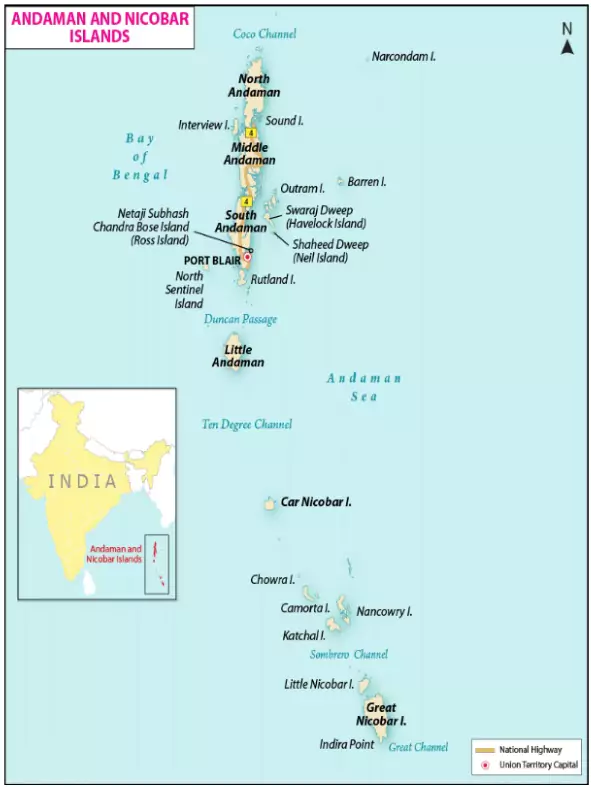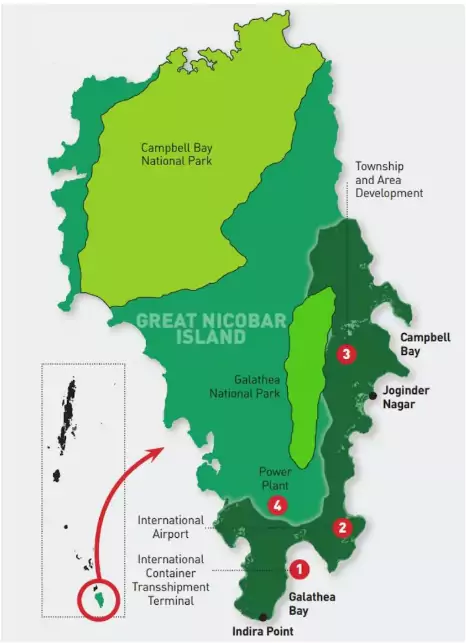The Union government is examining a complaint by the Tribal Council of Little and Great Nicobar regarding alleged violations of the Forest Rights Act (FRA), 2006.
- The complaint concerns the diversion of around 13,000 hectares of forest land for the ₹81,000-crore Great Nicobar Island project.
- The issue was raised after a certificate issued in August 2022 claimed that all forest rights had been identified and settled, which the Tribal Council disputes.
More on News
- Tribal Affairs Ministry action: Minister Jual Oram has asked the Chief Secretary of Andaman and Nicobar Islands for a “factual report” addressing each point in the complaint.
- Political interventions:
-
- The Leader of Opposition (Loksabha) wrote to the Minister urging proper implementation of the Forest Rights Act (FRA), 2006.
- Opposition also criticized the project as a “planned misadventure,” highlighting environmental and tribal rights concerns.
- Judicial oversight: A petition challenging forest clearances is pending in Calcutta High Court; Rajya Sabha queries remain unanswered citing sub-judice status.
About Great Nicobar Island Project
- Vision: A multi-component mega development project to transform Great Nicobar into a logistics, trade, and defence hub, improving India’s presence in the Indian Ocean.
About Andaman and Nicobar Islands Integrated Development Corporation Ltd (ANIIDCO)
- About: Quasi-government agency, incorporated in 1988 under the Companies Act.
- Objective: To develop and commercially exploit natural resources for the balanced and environment friendly development of the territory.
- Main activities: Trading of petroleum products, Indian made foreign liquor and milk, managing tourism resorts and infrastructure development for tourism and fisheries.
- Appointment as Project Proponent: Appointed by A&N administration in July 2020 for the Great Nicobar Project.
|
- Planned with environmental safeguards and tribal welfare compliance under EIA Notification 2006 and Shompen Policy 2015 to ensure sustainability
- Shompen Policy 2015: It is a regulatory framework established by the Andaman and Nicobar Administration to prioritize the welfare and rights of the indigenous Shompen tribe during large-scale development projects on Great Nicobar Island.
- Mandate: Tribal welfare and the protection of their cultural heritage and environment must take precedence over development initiatives.
- Implementing authority: The project is being implemented by the Port Blair-based Andaman and Nicobar Islands Integrated Development Corporation Ltd (ANIIDCO).
- Phased Timeline: Construction from 2024 onwards; partial operationalization by 2028, with full-scale development spread till 2050.
Key Components
- International Container Transhipment Terminal (ICTT): With a capacity of 14.2 million TEU, it will reduce India’s reliance on Colombo/Singapore and position the island as a global shipping hub.
- It is part of Maritime India Vision 2030 and Amrit Kaal Vision 2047, supporting India’s long-term economic strategy.
- Greenfield International Airport: Will improve air connectivity, promote tourism, and enable rapid deployment of troops and supplies in emergencies.
- 450 MVA Gas + Solar Power Plant: Ensures uninterrupted energy supply with a mix of conventional and renewable sources for sustainable growth.
- Integrated Township: A planned township over 16,610 hectares to provide housing, infrastructure, and modern amenities to residents and workers.
- Phased Development: Divided into three phases (2025–47) to spread investment, minimise ecological stress, and allow adaptive planning over two decades.
Location – Andaman Islands

- Divided into three major sub-groups: North Andaman, Middle Andaman, and South Andaman.
- Duncan Passage: Two major archipelagos of this group of islands are Little Andaman and the Great Andaman which are separated from each other by the 50 km wide Duncan Passage.
- It connects Andaman Sea to the Bay of Bengal
- Capital city Port Blair is located in South Andaman.
Location – The Nicobar Islands
- Divided into three major sub-groups: Northern, Central, and Southern Group
- Great Nicobar: Largest and the southernmost island in the group → Only 147 km away from Sumatra island of Indonesia.
- India’s southernmost point : ‘Indira Point’ is located at the southern tip of the Great Nicobar.
- Indigenous ethnic groups: Nicobarese and the Shompen
- ‘Ten Degree Channel’: It separatesAndaman Islands in the north from the Nicobar Islands in the south.
- Most of these islands have a volcanic base. They are made of tertiary sandstone, limestone, and shale.
- Barren and Narcondam islands in the North of Port Blair, are volcanic islands
- Saddle Peak (737 m) in North Andaman: It’s the highest peak in the Andaman and Nicobar Islands.
Location – Great Nicobar Island (GNI)

- Southernmost island of the Nicobar group of islands in the Bay of Bengal.
- Protected Sites:
- Great Nicobar Biosphere Reserve
- Campbell Bay National Park
- Galathea National Park
- Ecological Significance:
- High biodiversity with unique flora and fauna, including endangered species.
- Important for marine life and coral reefs.
- Designated a World Network of Biosphere Reserve by UNESCO in 2013.
|
Significance of the Project
- Strategic Location: Great Nicobar lies near the Malacca Strait, through which nearly 30%-40% of global trade, including a large share of China’s oil and gas imports, passes through this chokepoint.
- Offers India vantage positioning in the Indo-Pacific, strengthening maritime security and countering China’s “String of Pearls” strategy.
- Economic Potential: Projected revenue of ₹30,000 crore annually by 2040 and Creation of ~50,000 jobs in logistics, tourism, and allied sectors.
- Supports Sagarmala initiative and aims to make India a regional transshipment hub like Singapore/Hong Kong.
- Infrastructure Development: Four major components:
-
- Transshipment port (14.5M TEUs annually).
- Greenfield international airport.
- 450 MW power plant (Gas + Solar).
- Township for ~65,000 people.
- Improves connectivity and infrastructure in a remote region.
- Defence Importance: Enhances naval and air operational capacity in the eastern Indo-Pacific.
- Strengthens surveillance over choke points (Malacca, Sunda, and Lombok Straits).
- Complements India’s long-term strategic vision of Andaman & Nicobar as a security hub.
- It is aligned with India’s Act East Policy 2014 and the QUAD’s Indo-Pacific strategy, reinforcing regional security.
- Regional Diplomacy: Positions India as a trade and logistics leader in Bay of Bengal and BIMSTEC region. It helps in reducing dependency on foreign ports for transshipment.
Concerns Associated with the Project
- Ecological Concerns: Great Nicobar is a biodiversity hotspot (200 bird species, endemic flora, coral reefs).
- Galathea Bay: Critical nesting site for giant leatherback sea turtle and Ramsar wetland with protective mangroves.
- Large-scale dredging threatens marine ecosystems and increases risk in a seismically active zone.
- UNESCO World Heritage Site candidature could be jeopardized.
- Tribal Rights and FRA Issues
- Shompen Tribe (PVTG) (~300–400 people): Risk of displacement from 130 sq km of ancestral & sacred lands.
- Vulnerability to disease due to isolation (No immunity to outside pathogens).
- Nicobarese Community: Raised concerns of consent obtained “under pressure.”
- Forest Rights Act (2006):
- Requires recognition and settlement of rights before diversion of forest land.
- Complaint filed that administration falsely certified FRA compliance in 2022.
- Gram Sabha consent allegedly not properly obtained which is in violation of FRA spirit.
About Forest Rights Act, 2006 (FRA, 2006)
- Right of ownership: Scheduled Tribes and other traditional forest dwellers right of ownership, access to collect, use, and dispose of minor forest produce which has been traditionally collected within or outside village boundaries
- Eligibility: Forest rights can be claimed by any member or community → Who has for at least three generations (75 years) prior to the 13th day of December, 2005 primarily resided in forest land for bona fide livelihood needs.
- Nodal agency for the implementation of FRA , 2006: Union Ministry of Tribal Affairs (MoTA)
Authorities For Vesting Forest Rights
- Gram Sabha: Authority to initiate the process for determining the nature and extent of Individual Forest Rights (IFR) or Community Forest Rights (CFR) or both that may be given to FDST and OTFD.
- Sub-Divisional Level Committee: Constituted by the state government examines resolutions passed by the Gram Sabha.
- District Level Committee: Final approval of forest rights.
Forest Rights Act, 2006 recognises Four types of Rights
- Land Rights: Act Gives the forest dwellers the right to ownership to land farmed by them → Subject to a maximum of 4 hectares per family.
- Ownership is only for land that is actually being cultivated by the concerned family and no new lands can be granted.
- The land cannot be sold or transferred to anyone except by inheritance.
- Use Rights: Rights of the dwellers extend to extracting Minor Forest Produce (such as Bamboo, Tendu patta, Herbs, Medicinal plants etc.) grazing areas, to pastoralist routes, etc.
- Minor forest produce does not include timber.
- Relief and development rights: To rehabilitate in case of illegal eviction or forced displacement and to basic amenities, subject to restrictions for forest protection.
- Forest management rights: Includes the right to protect, regenerate or conserve or manage any community forest resource which they have been traditionally protecting and conserving for sustainable use.
|
- Governance and Institutional Concerns: ANIIDCO appointed as project proponent despite limited experience (previously handled liquor, milk, tourism resorts).
- Lack of environmental policy & expertise until 2022 → questions of credibility.
- Conflict of Interest: Same officials heading ANIIDCO also in charge of environmental oversight and clearances.
- Raises doubts about independent monitoring and transparency.
- Legal and Regulatory Concerns: Project area includes Coastal Regulation Zone (CRZ-1A) → normally prohibits large-scale construction.
- Environmental clearance by MoEFCC despite lack of preparedness flagged as irregular.
- Ongoing petitions before NGT & Calcutta High Court challenge forest clearances.
- Political & Social Concerns: Opposition parties (Congress, etc.) criticize the project as “planned misadventure.”
- Risk of becoming a politically divisive issue instead of a consensus-driven development plan.
Way Forward
- Ensure FRA Compliance: Conduct fresh Gram Sabha consultations with genuine participation of Nicobarese and Shompen tribes.
- Properly recognise and settle individual and community forest rights before proceeding.
- Independent Environmental Oversight: Establish an independent monitoring body (outside ANIIDCO and A&N administration) for environmental safeguards.
- Involve credible external experts in biodiversity and disaster management.
- Revamp ANIIDCO’s Capacity: Strengthen with professional staff (urban planners, ecologists, tribal welfare experts).
- Consider PPP model with reputed infrastructure agencies for execution, while ANIIDCO handles coordination.
- Adopt a Phased, Eco-Sensitive Approach: Begin with low-impact infrastructure (airport, renewable power) before port & township expansion.
- Integrate disaster-resilient design in a seismically active region.
- Explore eco-tourism and small-scale development as alternatives.
- Tribal Welfare Safeguards: Protect Shompen and Nicobarese rights with special resettlement and health safeguards.
- Ensure no forced displacement; incorporate tribal advisory councils in decision-making.
- Transparency & Public Dialogue: Release all clearance documents & progress reports in public domain.
- Build political consensus across parties to avoid polarisation on strategic projects.
Conclusion
The Great Nicobar Project has immense strategic and economic potential, but its success hinges on addressing ecological fragility, tribal rights under FRA, and governance lapses. A balanced, transparent, and eco-sensitive approach is the only way to reconcile India’s strategic ambitions with its constitutional and environmental obligations.
![]() 12 Sep 2025
12 Sep 2025

